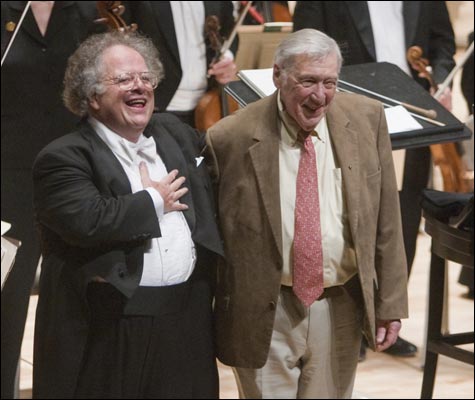
AFTER THE WORD ENDED: James Levine with Gunther Schuller after the premiere of Where the Word Ends. |
One of my most profound musical experiences took place when I was still a graduate student. A number of my fellow students were also classical-music lovers and record collectors, and we would occasionally get together to listen. I myself would be encouraged, especially by the salesmen at Sam Goody's, to buy the "definitive" version of any given piece — "definitive" meaning the salesman's favorite recording. But my friends were more sophisticated; they liked to compare different performances of the same work. I remember one particular session when each of us brought his favorite (in my case, it was also my only) recording of Mozart's Symphony in G minor, No. 40 — his penultimate symphonic work. The conductors were Arturo Toscanini, Wilhelm Furtwängler, Bruno Walter, and Otto Klemperer; except that the recordings included the same notes, they could have been of four different works. And they were all wonderful — powerful, convincing, memorable performances of a very great piece of music.
I was recalling this experience listening to James Levine and the Boston Symphony Orchestra play the G-minor and 11 other symphonies in a three-program Mozart "mini-festival." (I was out of town for the program with the very earliest symphonies and heard them rebroadcast on WGBH.) Levine's G-minor — the centerpiece of the last program, which included the other two symphonies in Mozart's uncanny final trilogy — was fast, urgent, energized, shapely, and, like all the symphonies, played with an impressive clarity of texture, even as the works themselves became increasingly multi-layered. Although his conducting didn't have Toscanini's driving intensity, or Furtwängler's nervous, almost neurotic interiority, or the depth of Klemperer's pathos, it had its own genuine if somewhat impersonal conviction in its understanding of the intent and structure of Mozart's mysterious score.
The three last symphonies make an especially good program because the contrasts are so pronounced: the autumnally pastoral E-flat, the poignant G-minor (every movement relentlessly in the minor), the dashing Jupiter, in which the classical symphony also absorbs Baroque polyphony. (In 1980, Kurt Masur made his BSO debut with this program, and he repeated it at Tanglewood in 2007.) I'd have preferred to hear even greater contrast among these works, more expansiveness, a more relaxed opening-out, and more of Mozart's sly insinuation. In the first movement of the Jupiter, Mozart quotes a jauntily sexy little aria, "Un bacio di mano" ("A Kiss on the Hand"), that he'd written for someone else's opera. Like most conductors, Levine didn't make this delicious moment any more playful than the rest, and he left out the quotation marks. In a way — which was not uninteresting — he played these symphonies as if they were parts of a single greater work.